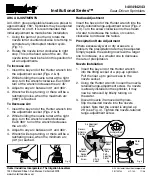
CAN-8x23 user’s manual (Revision 3.20, Ma r/08/2012) ------
29
3.2 SDO Introduction
In order to access the entries in a device object dictionary, service data
objects (SDOs) are provided. By means of the SDO communication method, a
peer-to-peer communication bridge between two devices is established, and
its transmission follows the client-server relationship. The general concept is
shown in the figure below.
Client
Server
confirmation
response
data
data
request
indication
The SDO has two kinds of the COB-IDs, RxSDOs and TxSDOs. They can
be viewed in the CANopen device. For example, users send a SDO message
to the CAN-8x23 by using RxSDO. On the contrary, the devices CAN-8x23
transmit a SDO message by using TxSDOS.
Before the SDO has been used, only the client can take the active
requirement for a SDO transmission. When the SDO client starts to transmit a
SDO, it is necessary to choose a proper protocol.
If the SDO client has to get the information from the device object
dictionary and from the SDO server, the segment upload protocol or block
upload protocol will be applied.
It is worth to be mentioned, the front protocol is used for transmitting fewer
data; the latter protocol is used for transmitting larger data. Both the segment
download protocol and block download protocol will work when the SDO client
wants to modify the object dictionary to the SDO server. The differences
between the segment download protocol and the block download protocol are
similar to the differences between the segment upload protocol and the block
upload protocol. Because of the different access types in the object dictionary,
not all accessing action of the object dictionary via the SDO transmission is
allowed. If the SDO client trends to modify the entries of the SDO server object
dictionary which uses the read-only access type, the abort SDO transfer
















































